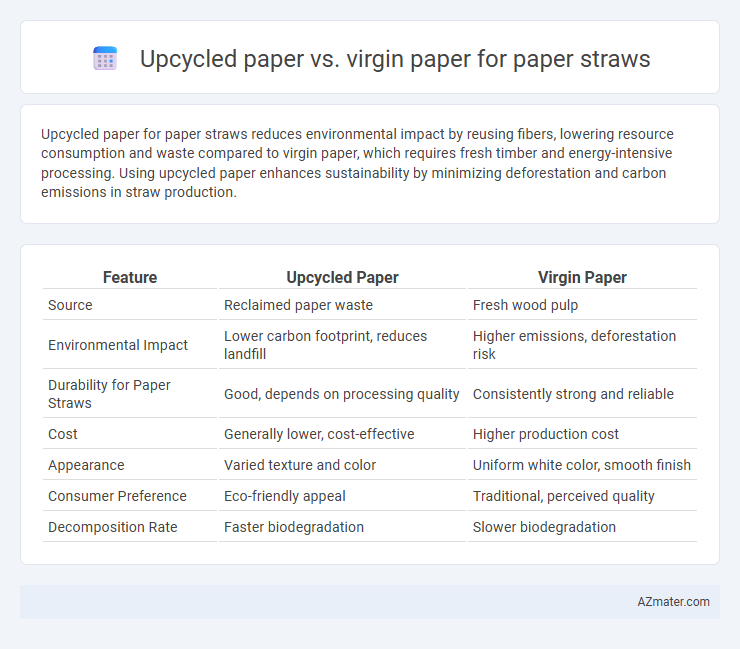Upcycled paper for paper straws reduces environmental impact by reusing fibers, lowering resource consumption and waste compared to virgin paper, which requires fresh timber and energy-intensive processing. Using upcycled paper enhances sustainability by minimizing deforestation and carbon emissions in straw production.
Table of Comparison
| Feature | Upcycled Paper | Virgin Paper |
|---|---|---|
| Source | Reclaimed paper waste | Fresh wood pulp |
| Environmental Impact | Lower carbon footprint, reduces landfill | Higher emissions, deforestation risk |
| Durability for Paper Straws | Good, depends on processing quality | Consistently strong and reliable |
| Cost | Generally lower, cost-effective | Higher production cost |
| Appearance | Varied texture and color | Uniform white color, smooth finish |
| Consumer Preference | Eco-friendly appeal | Traditional, perceived quality |
| Decomposition Rate | Faster biodegradation | Slower biodegradation |
Introduction to Upcycled Paper and Virgin Paper
Upcycled paper, made from repurposed waste materials, offers an eco-friendly alternative to virgin paper, which is produced directly from fresh wood pulp harvested from trees. Upcycled paper minimizes environmental impact by reducing deforestation, lowering energy use, and diverting waste from landfills, making it ideal for sustainable paper straw production. Virgin paper, though known for its durability and consistency, contributes to higher carbon emissions and resource depletion, positioning upcycled paper as a greener choice in the pursuit of environmentally responsible paper straw manufacturing.
Environmental Impact Comparison
Upcycled paper straws significantly reduce deforestation and landfill waste by repurposing existing paper materials, whereas virgin paper straws require cutting down trees and extensive water consumption for pulp production. The carbon footprint of producing upcycled paper straws is lower due to less intensive processing and energy usage compared to virgin paper manufacturing. Biodegradability of both types is similar, but upcycled paper straws promote circular economy practices, making them a more sustainable choice for reducing environmental impact.
Raw Material Sourcing and Sustainability
Upcycled paper straws utilize post-consumer waste and recycled fibers, significantly reducing the demand for virgin wood pulp and minimizing deforestation impacts. Virgin paper straws rely on newly harvested timber, contributing to higher energy consumption and greater carbon emissions throughout raw material extraction and processing. Choosing upcycled paper as the primary raw material enhances sustainability by lowering landfill waste, conserving natural resources, and supporting circular economy principles in eco-friendly packaging solutions.
Manufacturing Processes and Resource Use
Upcycled paper straws utilize pre-consumer or post-consumer paper waste, reducing the need for virgin fiber extraction and lowering energy consumption during production. Virgin paper straws rely on fresh wood pulp, demanding higher water usage and chemical inputs for pulping and bleaching processes. Manufacturing upcycled paper straws minimizes environmental impact by conserving natural resources and decreasing landfill waste compared to virgin paper alternatives.
Strength and Durability in Paper Straws
Upcycled paper used in paper straws offers moderate strength but may lack the consistent durability found in virgin paper products, as recycled fibers tend to be shorter and weaker. Virgin paper fibers maintain higher tensile strength, resulting in paper straws that are more resistant to bending and breaking during prolonged use. The durability of virgin paper ensures better structural integrity, making it the preferred choice for paper straws requiring reliable performance in various beverage environments.
Food Safety and Chemical Concerns
Upcycled paper straws minimize chemical exposure by using recycled fibers and avoiding the harsh bleaching processes common in virgin paper production, reducing potential contamination risks. Virgin paper often undergoes intensive chemical treatments, including chlorine-based bleaches, which can leave residues harmful to food safety. Choosing upcycled paper for straws supports safer consumption by lowering the likelihood of chemical leaching into beverages.
Cost Analysis and Economic Factors
Upcycled paper straws generally offer lower production costs due to reduced raw material expenses and less energy-intensive processing compared to virgin paper straws, which require fresh pulp and higher chemical treatments. Economic factors such as market demand for sustainable products and government incentives for eco-friendly manufacturing further enhance the cost-effectiveness of upcycled paper straws. While virgin paper straws may have higher initial costs, their consistent quality and strength can justify price premiums in certain commercial sectors.
Consumer Perception and Market Trends
Consumers increasingly favor upcycled paper straws over virgin paper due to growing environmental awareness and demand for sustainable products. Market trends indicate a surge in brands adopting upcycled paper, reflecting positive consumer perception of eco-friendly alternatives that reduce waste and carbon footprint. Studies show that upcycled paper straws gain higher acceptance in eco-conscious demographics, driving the shift within the paper straw industry.
Regulatory Standards and Certification
Upcycled paper for paper straws is increasingly favored due to its compliance with stringent regulatory standards such as FDA and EU food contact safety regulations, reflecting sustainability and safety priorities. Virgin paper, while traditionally used, often faces scrutiny regarding environmental impact but meets the same certification demands including FSC and SGS for quality assurance. Certifications like FSC, PEFC, and ISO 14001 are crucial for both materials, ensuring traceability, environmental responsibility, and adherence to industry standards in paper straw manufacturing.
Future Prospects for Sustainable Paper Straws
Upcycled paper offers significant environmental benefits for paper straws by reducing waste and minimizing the demand for virgin pulp, contributing to a circular economy. Virgin paper, while traditionally used, consumes more natural resources and generates higher carbon emissions compared to upcycled alternatives. Future prospects for sustainable paper straws strongly favor upcycled materials due to increasing consumer demand for eco-friendly products and advancements in recycling technologies that enhance durability and biodegradability.

Infographic: Upcycled paper vs Virgin paper for Paper straw
 azmater.com
azmater.com